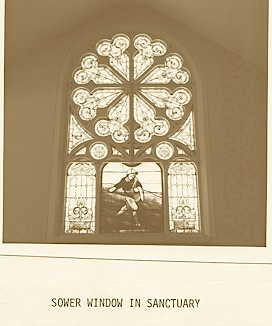Our Windows

People are like stained-glass windows.
They sparkle and shine when the sun is out,
but when darkness sets in,
their true beauty is revealed only if there is a light from within.
—Elizabeth Kubler-Ross
The unique design of the beautiful stained-glass windows bring a never-to-be-forgotten charm to this building. The glass is a special type made only in Europe and replacement pieces have not been available for many years.
Two large arch-shaped windows are in the east and west walls of the sanctuary, and one on the west wall of the parlor. These windows have a large circular window at the top divided into eight scissorlike sections, then two smaller circular windows with a quatrefoil design, formed by four overlapping circles. Four small vertical swinging windows complete these windows. The four small windows on the east window were donated by the Ladies Aid Society and the Missionary Society. Those on the west window were donated by the Sabbath School.

The arch-shaped "Sower" window located up high on the north wall is a memorial to Rev. James Aikman Carnahan. This window has a large round window at the top divided into eight scissorlike sections, then two small round windows below and at the bottom a picture of the "Sower." The two side panels are inscribed with the dates of his birth, death, and pastorate at Dayton. The inspiration for the design is not known, but former member Kay Dexter discovered that the Sower window bears a strong resemblance to a painting by Jean Francois Millet, also called The Sower, painted in 1850, and a later painting by Vincent Van Gogh of the same name.
There are two small arch type windows, one on the east wall, dedicated to the memory of Rev. C.A. Kanouse, and one on the west wall. These windows have four small circular windows at the top, arranged like the four corners of a square, and two-arch shaped panels side by side below.
It is not known what symbolism the designer of these windows intended to portray; however, a short discussion of Christian symbols which might be represented in the windows may help each viewer to a better appreciation of them. A circle, a figure without beginning or ending, is often used to represent God, who is both eternal and one. A triangle or a three-pointed curved figure call a trefoil is a used to represent the Holy Trinity. Four circles either separately or overlapping to form a quatrefoil are symbolic of the four gospels or evangelists. The figure eight or a figure with eight sides or sections is symbolic of rebirth and therefore baptismal fonts are usually octagonal in shape. The origin of this symbol may go back to the story of the great flood in which eight souls were saved in Noah’s ark. Another tradition believes that since seven days were used by God in creation and rest, the eighth day signified “a new creation” or regeneration—a Divine Octave.
Wheat is a symbol for bread. The open crown is a symbol for the reward of the faithful in the life that lies beyond the death of the body. It also can represent the crown of glory, symbolic of the kingly office of Christ. The open Bible can signify the Word of God or the Gospel. A Greek cross with arms of equal length symbolizes the spread of the Gospel to the four quarters of the earth. This combined with an X forms an eight-arm figure which can represent many ideas. The eight divided sections of the large windows form this figure.
Excerpts from 150 Years In the Life of Dayton Memorial Presbyterian Church, by Kenneth E. Yost (Dayton, Ind.: Dayton Memorial Presbyterian Church, 1999). Information provided by Kay Dexter has been inserted.

